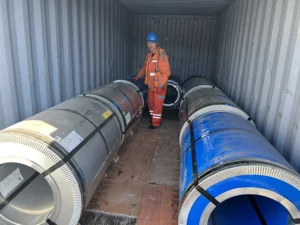Introduction
In today’s global push for energy efficiency, materials used in power distribution systems play a pivotal role. Among these materials, cold rolled grain oriented steel (CRGO) is particularly important due to its magnetic properties and ability to reduce energy losses in electrical transformers. This blog explores the characteristics, applications, and advantages of cold rolled grain oriented steel, with a special focus on the European and Middle Eastern markets.
What Is Cold Rolled Grain Oriented Steel?
Cold rolled grain oriented steel is a type of electrical steel that has been processed to align the grain structure in the rolling direction. This orientation significantly improves magnetic properties, particularly in the direction of the rolling, resulting in lower core losses in transformers. The cold rolling process refines the grain structure and enhances the material’s performance in alternating magnetic fields.
This steel type typically has a silicon content of around 3%, which helps to increase electrical resistivity and reduce eddy current losses. A surface coating is usually applied to improve insulation resistance and minimize aging during operation.
Manufacturing Process of CRGO Steel
The production of cold rolled grain oriented steel involves several stages:
- Hot Rolling: The initial slab is hot rolled to produce a thinner, more workable sheet.
- Cold Rolling: The steel is then cold rolled to refine the grain structure.
- Annealing: This heat treatment enhances the magnetic properties and recrystallizes the grain structure.
- Decarburization: Carbon is removed to reduce core losses.
- Coating: An insulating coating is applied to improve electrical performance and corrosion resistance.
These processes are closely monitored and adjusted to ensure the desired grain orientation and low core loss values, essential for high-performance transformers.
Applications of CRGO Steel
The most common use of cold rolled grain oriented steel is in the manufacturing of transformer cores. These cores are used in:
- Power transformers
- Distribution transformers
- Instrument transformers
- Reactors
- Magnetic amplifiers
Because of its low hysteresis and eddy current losses, CRGO steel is ideal for applications where energy efficiency and reduced operational costs are critical.
Benefits of Using CRGO Steel
The benefits of cold rolled grain oriented steel include:
- Low Core Loss: Reduced power loss during magnetization cycles.
- High Magnetic Permeability: Enhances the efficiency of transformers.
- Dimensional Stability: Maintains physical and magnetic properties over time.
- Long Service Life: Resists degradation under electrical and thermal stress.
- Eco-Friendly: Supports energy conservation initiatives by improving transformer performance.
Market Trends and Demand
The global demand for cold rolled grain oriented steel is increasing steadily due to the expansion of power grids and renewable energy installations. In Europe, CRGO steel is used extensively in smart grid projects and high-efficiency distribution networks. Meanwhile, the Middle East, with its rising energy infrastructure investments, shows strong demand for advanced electrical materials, including CRGO.
Key market trends include:
- Shift toward low-loss materials: Regulatory requirements for energy efficiency are pushing manufacturers toward high-grade CRGO.
- Growth in renewable energy: Wind and solar power systems require efficient transformers, driving up demand.
- Urbanization: Increased energy needs in cities are fueling investment in transformer upgrades.
Quality Standards and Grades
Cold rolled grain oriented steel is categorized into conventional grades (e.g., M3, M4, M5, M6) and high-grade types (e.g., HI-B, laser scribed). These grades are classified based on core loss and thickness.
Some widely recognized standards include:
- ASTM A876 – Standard for silicon steel sheet
- IEC 60404-8-7 – Specification for grain-oriented electrical steel
- JIS C2552 – Japanese standard for CRGO
Understanding these standards is crucial for manufacturers and buyers to ensure consistent performance in different applications.
CRGO Steel vs. Non-Grain Oriented Steel
While cold rolled grain oriented steel is optimized for unidirectional magnetization, non-grain oriented (NGO) electrical steel is used where magnetic fields vary in multiple directions. NGO is commonly found in motors and generators, whereas CRGO is preferred for static magnetic applications like transformers.
Key differences:
| Feature | CRGO Steel | NGO Steel |
|---|---|---|
| Grain orientation | Aligned in rolling direction | Randomly oriented |
| Magnetic loss | Low | Higher than CRGO |
| Typical applications | Transformers | Electric motors, generators |
Challenges in CRGO Production
Producing cold rolled grain oriented steel is technically demanding. Precise control over chemical composition, rolling conditions, and heat treatments is essential to achieve the required magnetic properties. Any variation can lead to performance issues in the end-use applications.
Furthermore, geopolitical instability and raw material price fluctuations can affect the supply chain. Buyers in Europe and the Middle East often seek long-term, stable suppliers to mitigate these risks.
Choosing a Reliable Supplier
When sourcing CRGO steel, especially for critical applications in transformers and energy infrastructure, it’s essential to consider:
- Certifications (ISO, IEC, etc.)
- Consistent supply
- Technical support
- Competitive pricing
- Customized solutions
Manufacturers who can offer value-added services like slitting, cutting, and testing often have a competitive edge in international markets.
Conclusion
Cold rolled grain oriented steel remains one of the most essential materials for ensuring high performance in electrical transformers. Its superior magnetic properties, energy efficiency, and reliability make it indispensable in today’s power distribution systems. With increasing demand from the European and Middle Eastern energy sectors, investing in high-quality CRGO steel is a strategic decision for manufacturers and energy companies alike.
Whether you’re a transformer producer, a distributor, or an energy project developer, understanding the characteristics and market dynamics of cold rolled grain oriented steel can help you make informed sourcing decisions and stay competitive in a rapidly evolving industry.




